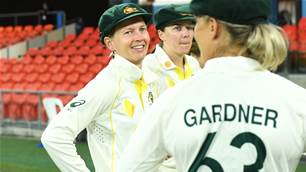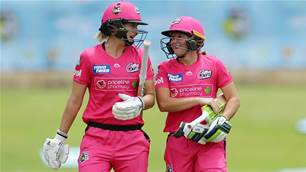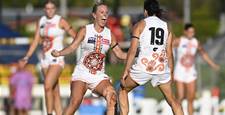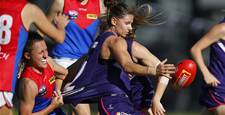Sarah Styles, Head of Female Engagement, and Kim McConnie, who oversees the men’s and women’s Big Bash League, are two of the women changing the game at Cricket Australia.
We meet on the anniversary of the WBBL launch, which was launched in Sydney three years ago to the day. Styles fondly remembers that moment - the rush to get uniforms that fit and the feeling that 2015 was going to be transformative for Australian women in sport, with recent successes from the Diamonds and the Matildas.
On this day three years ago today, we launched a little something called @WBBL on Sydney Harbour... pic.twitter.com/gLmDwvdjzK
— Sarah Styles (@SarahStylesAU) July 10, 2018
McConnie, who took on the role last year, notes and praises the investment that the AFL and Cricket Australia, in particular, have made when it comes to women’s sport.
“It’s not a revenue driver for either league yet and that’s not the objective or the intent,” she explains.
“At some point you have to say ‘we’re going to make an investment, we’re going to build it.’ I think of women’s sport a bit like the movie Field of Dreams - if you build it, they will come.”
“It’s so circular, isn’t it?” Styles adds.
“A lot of people use the argument against women’s sport that people aren’t watching, so therefore we won’t invest. When actually, if you do invest and focus on developing fans, there will be fans. It expands to the amount of media and broadcast coverage, the commercial interest, which then lets the cycle continue and build.
What cricket did well is that it considered, predating both of our time here, where can they step in to speed up that cycle?”
Styles recalls a Women in Sport media grant a few years ago that allowed the Australian women’s team to have a journalist travel with them to major tournaments, garnering more media coverage back home.
“Sports need to be okay with knowing that the women’s game can actually grow the overall game,” Styles concludes.
“I think and I hope we’re moving past it as an industry, but for a while there was this sense of a fixed pie, where if women get more that’s less for men. But if we do this right, the pie will grow for everyone. I’m always so surprised that more male athletes aren’t passionate advocates because they will also benefit if we all get this right.”
TWG asked Styles and McConnie what the ideal world for Australian women in cricket would look like and how they were working towards that goal.
“The ideal for me has been clear since the role was created – which is that the role is no longer needed!” Styles laughs.
“I’m actively trying to do myself out of a job. To get to the point where the role is not needed because everyone within the sport understands why engagement of women and girls is important and how to go about it in an accurate and productive way. So there’s 700 people working towards female engagement, and then I ride off into the sunset.”
Styles is aware that’s not simply the end though, and there is a gap within cricket that still needs to be closed.
“We’re really conscious of how our language and symbols reinforce certain things,” she explains.
“Even a couple of years ago, without meaning to, this was reinforcing a really rich history of the men’s game while not really being inclusive of the whole population.
“We’re driven by our vision to be Australia’s favourite sport and a sport for all. What does that mean as far as creating the environment where our fan and participant base reflect the population?
"We’re talking gender today but that also means more than gender. We want cricket to become the leading sport for women and girls. We look at leadership, our workforce, at a community level with girls playing, the strongest talent pathway to help elite athletes develop, and also just as fans.
“Because that’s completely okay, it’s not just about getting women to play. How can the Big Bash League and international cricket make people feel involved and entertained?”
“To build on that, I just want people to want to cross the road to watch women’s cricket,” McConnie concludes.
“I don’t think we’re at that point yet. We deliberately make every game free, we want to invite people into the experience.
“The great thing though is is that once we get people to do it, they come back. Our event experience is something which people find amazing. We just need people to cross the road, to come along and sit down and invest that 3 hours.
“Having that broadcast on TV plays a key role. If you see a great game and you see the experience then you want to come along. We all know that’s when that emotional attachment is formed, right? That’s how memories are made. You think about going with your friends at a young age, your grandad, whoever, that’s where you form that attachment.”
It was recently announced that, in 2019, the Women’s Big Bash League will operate as a standalone competition from the men’s series.
“We’ve had pretty much universal support for it because one of the challenges we have at the moment is that it just gets lost in the clutter,” McConnie says, her eyes lighting up.
“Women’s elite cricket has earned its right, so why wouldn’t you have it standalone? That’s what we’re working through at the moment and how we can bring that to life.”
Women’s cricket, like most women’s sport, has relied upon doubleheaders for a long time, often to access television broadcasts.
The #WBBL04 schedule has just landed, featuring standalone finals and a blockbuster Opening Weekend in Melbourne! https://t.co/4yEFDXdBM0
— Rebel Women's Big Bash League (@WBBL) July 16, 2018
“By the men and women playing on the same ground it was much easier to be able to get support from broadcast partners,” Styles explains.
“The challenge is what does that structure look like with cricket? If you have two 3 hour games and there’s a two hour gap in the middle, unfortunately, it’s not really optimised for people who are there in person.
“Because there’s not many people there, somebody watches on the television and they don’t actually judge the product. They don’t judge what they’re seeing on the field. Without realising it, they judge the whole thing as ‘there’s no one there so it mustn’t be any good, therefore I think it’s no good’. It fed into this misconception of the quality of the sport and that was a challenge.”
The Women in Sport Summit will take place at the MCG in Melbourne between August 21 and 23. The summit highlights the key areas where female audiences, athletes, and executives are growing and changing the business of sport.
Styles and McConnie will be just two of the names from Cricket Australia presenting. On the first day, Styles will be talking about accountability using the example of Cricket Australia’s annual Press for Progress report. The document was released for the first time in March.
Today, we release our first annual #PressForProgress Report - a national commitment to be more transparent for the progress for women and girls in cricket #IWD2018 https://t.co/4eMC8ZuAzf
— Sarah Styles (@SarahStylesAU) March 7, 2018
“This is an annual monitor that we’ll release publicly to show how we’re performing against our strategy,” she explains. “Everybody at Cricket Australia knows that. If we’ve got a positive story to tell, we’ll release it. If we’ve got a neutral or negative story to tell, we’ll still be telling it.
“We’re doing that in order to be more transparent around what’s happening and what we’re trying to achieve, and to drive that public accountability.
“If we miss something or don’t deliver, we want people to be annoyed. I think what sports don’t want is apathy. That’s probably a whole separate conversation but we want people to be challenging cricket on it - like ‘hang on you said you were going to do this, why aren’t you doing this?’”
Related Articles

Australian Women's Cricket Commonwealth Games squad named

Women's Big Bash League kicks off: Your full WBBL preview

.jpg&h=600&w=850&c=0&s=1)











